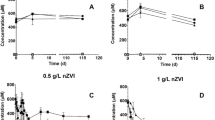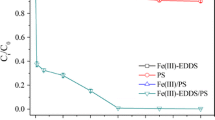Abstract
Abiotic iron monosulfide (FeS) has attracted growing interests in dechlorinating trichloroethylene (TCE) in anoxic groundwater, but it is still unclear how biogenic FeS affects the dechlorination and thus the cytotoxity of TCE. In this work, a biogenic FeS was synthesized by Shewanella oneidensis MR-1 with addition of ferrihydrite and S0, and it was used for dechlorination of TCE in alkaline environment and the de-cytotoxicity was evaluated by the growth of Synechocystis sp. PCC6803. The results show that the biogenic FeS was of mackinawite, with a loose flower-like mosaic structure. The dechlorination of TCE by the biogenic FeS was accelerated by 6 times than that by abiotic FeS. TCE was dechlorinated mainly by hydrogenolysis to form dichloroethane (C2H2Cl2), vinyl chloride (C2H3Cl), and finally ethylene, accompanied with transformation of both Fe2+ to Fe3+ and monosulfide to disulfide and polysulfide on the biogenic FeS surface. The concentration for 50% of maximal inhibition effect (EC50) of TCE to Synechocystis was 486 mg/L and the inhibition to Synechocystis under the EC50 was relieved more significantly on addition of the biogenic FeS than that of abiotic FeS. These results indicate that the biogenic FeS promoted the dechlorination and thus de-cytotoxity of TCE.
Graphic abstract






Similar content being viewed by others
References
Yan J, Gao W, Dong M, Han L, Qian L, Nathanail CP, Chen M (2016) Degradation of trichloroethylene by activated persulfate using a reduced graphene oxide supported magnetite nanoparticle. Chem Eng J 295:309–316
Bácsi I, Török T, B-Béres V, Török P, Tóthmérész B, Nagy AS, Vasas G (2012) Laboratory and microcosm experiments testing the toxicity of chlorinated hydrocarbons on a cyanobacterium strain (Synechococcus PCC 6301) and on natural phytoplankton assemblages. Hydrobiologia 710:189–203
Dong H, Zhang C, Deng J, Jiang Z, Zhang L, Cheng Y, Hou K, Tang L, Zeng G (2018) Factors influencing degradation of trichloroethylene by sulfide-modified nanoscale zero-valent iron in aqueous solution. Water Res 135:1–10
Purdue MP (2013) Trichloroethylene and Cancer. JNCI-J Natl Cancer Inst 105:844–846
Fu D, Zhang Q, Fan Z, Qi H, Wang Z, Peng L (2019) Aged microplastics polyvinyl chloride interact with copper and cause oxidative stress towards microalgae Chlorella vulgaris. Aquat Toxicol 216:105319
Burchardt AD, Carvalho RN, Valente A, Nativo P, Gilliland D, Garcia CP, Passarella R, Pedroni V, Rossi F, Lettieri T (2012) Effects of silver nanoparticles in diatom Thalassiosira pseudonana and cyanobacterium Synechococcus sp. Environ Sci Technol 46:11336–11344
Guo Z, Brusseau ML, Fogg GE (2019) Determining the long-term operational performance of pump and treat and the possibility of closure for a large TCE plume. J Hazard Mater 365:796–803
Quinlivan PA, Li L, Knappe DR (2005) Effects of activated carbon characteristics on the simultaneous adsorption of aqueous organic micropollutants and natural organic matter. Water Res 39:1663–1673
Crimi ML, Siegrist RLJJoEE, (2005) Factors Affecting Effectiveness and Efficiency of DNAPL Destruction Using Potassium Permanganate and Catalyzed Hydrogen Peroxide. J Environ Eng 131:1724–1732
Yuan B, Chen Y, Fu M-L (2012) Degradation efficiencies and mechanisms of trichloroethylene (TCE) by controlled-release permanganate (CRP) oxidation. Chem Eng J 192:276–283
Young C, Lim TM, Chiang K, Scott J, Amal R (2008) Photocatalytic oxidation of toluene and trichloroethylene in the gas-phase by metallised (Pt, Ag) titanium dioxide. Appl Catal B 78:1–10
Yasunaga N, Hirotsuji JJOS (2008) Efficient decomposition of trichloroethylene (TCE) in groundwater by ozone-hydrogen peroxide treatment. Ozone-Sci Eng 30:127–135
Ruiz N, Seal S, Reinhart DJ, Jo HM (2001) Surface chemical reactivity in selected zero-valent iron samples used in groundwater remediation. J Hazard Mater 80:107–117
Han Y, Liu C, Horita J, Yan W (2018) Trichloroethene (TCE) hydrodechlorination by NiFe nanoparticles: Influence of aqueous anions on catalytic pathways. Chemosphere 205:404–413
Xiao X, Zhu W-W, Yuan H, Li W-W, Li Q, Yu H-Q (2016) Biosynthesis of FeS nanoparticles from contaminant degradation in one single system. Biochem Eng J 105:214–219
Chen Y, Liang W, Li Y, Wu Y, Chen Y, Xiao W, Zhao L, Zhang J, Li H (2019) Modification, application and reaction mechanisms of nano-sized iron sulfide particles for pollutant removal from soil and water: A review. Chem Eng J 362:144–159
Li D, Peng P, Yu Z, Huang W, Zhong Y (2016) Reductive transformation of hexabromocyclododecane (HBCD) by FeS. Water Res 101:195–202
Hyun SP, Hayes KF (2015) Abiotic reductive dechlorination of cis-DCE by ferrous monosulfide mackinawite. Environ Sci Pollut Res Int 22:16463–16474
Lan Y, Elwood Madden AS, Butler EC (2016) Transformation of mackinawite to greigite by trichloroethylene and tetrachloroethylene. Environ Sci Process Impacts 18:1266–1273
Butler EC, Hayes KF (1998) Effects of solution composition and pH on the reductive dechlorination of hexachloroethane by iron sulfide. Environ Sci Technol 32:1276–1284
Elsner M, Schwarzenbach RP, Haderlein SB (2004) Reactivity of Fe(II)-bearing minerals toward reductive transformation of organic contaminants. Environ Sci Technol 38:799–807
Henderson AD, Demond AH (2013) Permeability of iron sulfide (FeS)-based materials for groundwater remediation. Water Res 47:1267–1276
Zhou L, Liu J, Dong F (2017) Spectroscopic study on biological mackinawite (FeS) synthesized by ferric reducing bacteria (FRB) and sulfate reducing bacteria (SRB): Implications for in-situ remediation of acid mine drainage. Spectrochim Acta A Mol Biomol Spectrosc 173:544–548
Chen Y, Liang W, Li Y, Wu Y, Chen Y, Xiao W, Zhao L, Zhang J, Li H (2018) Modification, application and reaction mechanisms of nano-sized iron sulfide particles for pollutant removal from soil and water: A review. Chem Eng J 362:144–159
Kim S, Park T, Lee W (2015) Enhanced reductive dechlorination of tetrachloroethene by nano-sized mackinawite with cyanocobalamin in a highly alkaline condition. J Environ Manage 151:378–385
Flynn TM, O'Loughlin EJ, Mishra B, DiChristina TJ, Kemner KM (2014) Sulfur-mediated electron shuttling during bacterial iron reduction. Science 344(6187):1039–1042
Gong Y, Tang J, Zhao D (2016) Application of iron sulfide particles for groundwater and soil remediation: A review. Water Res 89:309–320
Benedetto J, De Almeida S, Gomes H, Vazoller R, Ladeira ACQ (2005) Monitoring of sulfate-reducing bacteria in acid water from uranium mines. Minerals Eng 18:1341–1343
Hazra C, Kundu D, Chaudhari A, Jana T (2013) Biogenic synthesis, characterization, toxicity and photocatalysis of zinc sulfide nanoparticles using rhamnolipids from Pseudomonas aeruginosa BS01 as capping and stabilizing agent. J Chem Technol Biotechnol 88:1039–1048
Narayanan KB, Park HH, Sakthivel N (2013) Extracellular synthesis of mycogenic silver nanoparticles by Cylindrocladium floridanum and its homogeneous catalytic degradation of 4-nitrophenol. Spectrochim Acta A Mol Biomol Spectrosc 116:485–490
Fan XL, Lv SQ, Xia JL, Nie ZY, Zhang DR, Pan X, Liu LZ, Wen W, Zheng L, Zhao YD (2019) Extraction of Al and Ce from coal fly ash by biogenic Fe3+ and H2SO4. Chem Eng J 370:1407–1424
Jeong HY, Hayes KF (2003) Impact of transition metals on reductive dechlorination rate of hexachloroethane by mackinawite. Environ Sci Technol 37:4650–4655
Kiss E (2001) Organisation for economic co-operation and development (OECD): The OECD guides for multinational enterprises. Inter Leg Materials 40:236–246
Maji SK, Dutta AK, Biswas P, Srivastava DN, Paul P, Mondal A, Adhikary B (2012) Synthesis and characterization of FeS nanoparticles obtained from a dithiocarboxylate precursor complex and their photocatalytic, electrocatalytic and biomimic peroxidase behavior. Appl Catal A 419–420:170–177
Shih YJ, Hsia KF, Chen CW, Chen CF, Dong CD (2019) Characteristics of trichloroethene (TCE) dechlorination in seawater over a granulated zero-valent iron. Chemosphere 216:40–47
Renock D, Gallegos T, Utsunomiya S, Hayes K, Ewing RC (2009) Chemical and structural characterization of as immobilization by nanoparticles of mackinawite (FeSm). Chem Geol 268:116–125
Zhang DR, Chen HR, Xia JL, Nie ZY, Fan XL, Liu HC, Zheng L, Zhang LJ, Yang HY (2020) Humic acid promotes arsenopyrite bio-oxidation and arsenic immobilization. J Hazard Mater 384:121–359
Villem A, Henri-Charles D, Kaja K, Anne K (2009) Toxicity of nanoparticles of CuO, ZnO and TiO2 to microalgae Pseudokirchneriella subcapitata. Sci Total Environ 407:1461–1468
Liu J, Valsaraj KT, Devai I, DeLaune RD (2008) Immobilization of aqueous Hg(II) by mackinawite (FeS). J Hazard Mater 157:432–440
Herbert RB Jr, Benner SG, Pratt AR, Blowes DW (1998) Surface chemistry and morphology of poorly crystalline iron sulfides precipitated in media containing sulfate-reducing bacteria. Chem Geology 144:87–97
Liang CH, Wang H, Huang NB (2014) Effects of Sulphate-reducing bacteria on corrosion behaviour of 2205 duplex stainless steel. J Iron Steel Res Int 21:444–450
Remazeilles C, Tran K, Guilminot E, Conforto E (2013) Study of Fe (II) sulphides in waterlogged archaeological wood. Stud Conserv 58:297–307
Bourdoiseau JA, Jeannin M, Rémazeilles C, Sabot R, Refait P (2011) The transformation of mackinawite into greigite studied by Raman spectroscopy. J Raman Spectrosc 42:496–504
Jeong HY, Lee JH, Hayes KF (2008) Characterization of synthetic nanocrystalline mackinawite: crystal structure, particle size, and specific surface area. Geochim Cosmochim Acta 72:493–505
Li C, Lu Q, Zhan C, Tariq M, Huang K, Liu F, Zhu F, Liu G, Cui C, Lin K (2019) Efficient novel amphiphilic double shells layer coupled with nanoscale zero-valent composite for the degradation of trichloroethylene. Sci Total Environ 659:821–827
Lyu H, Zhao H, Tang J, Gong Y, Huang Y, Wu Q, Gao B (2018) Immobilization of hexavalent chromium in contaminated soils using biochar supported nanoscale iron sulfide composite. Chemosphere 194:360–369
Burris DR, Delcomyn CA, Smith MH, Roberts AL (1996) Reductive dechlorination of tetrachloroethylene and trichloroethylene catalyzed by vitamin B12 in homogeneous and heterogeneous systems. Environ Sci Technol 30:3047–3052
Roberts AL, Totten LA, Arnold WA, Burris DR, Campbell TJ (1996) Reductive elimination of chlorinated ethylenes by zero-valent metals. Environ Sci Technol 30:2654–2659
Tobiszewski M, Namiesnik J (2012) Abiotic degradation of chlorinated ethanes and ethenes in water. Environ Sci Pollut Res Int 19:1994–2006
Choi J, Choi K, Lee W (2009) Effects of transition metal and sulfide on the reductive dechlorination of carbon tetrachloride and 1,1,1-trichloroethane by FeS. J Hazard Mater 162:1151–1158
Scheinost AC, Kirsch R, Banerjee D, Fernandez-Martinez A, Zaenker H, Funke H, Charlet L (2008) X-ray absorption and photoelectron spectroscopy investigation of selenite reduction by FeII-bearing minerals. J Contam Hydrol 102:228–245
Jeong HY, Han Y-S, Park SW, Hayes KF (2010) Aerobic oxidation of mackinawite (FeS) and its environmental implication for arsenic mobilization. Geochim Cosmochim Acta 74:3182–3198
Lan Y, Butler EC (2016) Iron-sulfide-associated products formed during reductive dechlorination of carbon tetrachloride. Environ Sci Technol 50:5489–5497
Huo YC, Li WW, Chen CB, Li CX, Zeng R, Lau TC, Huang TY (2016) Biogenic FeS accelerates reductive dechlorination of carbon tetrachloride by Shewanella putrefaciens CN32. Enzyme Microb Technol 95:236–241
Acknowledgements
This work was supported by the National Natural Science Foundation of China (NSFC No. 51861135305), the Open Funds of Beijing Synchrotron Radiation Facility (2019-BEPC-PT-003349 and 2019-BEPC-PT-003350), the Fundamental Research Funds for the Central Universities of Central South University (Grant no. 1053320181686) and the Open-End Fund for the Valuable and Precision Instruments of Central South University (CSUZC201807).
Author information
Authors and Affiliations
Corresponding author
Ethics declarations
Conflict of interest
The authors declare that they have no confict of interest.
Additional information
Publisher's Note
Springer Nature remains neutral with regard to jurisdictional claims in published maps and institutional affiliations.
Electronic supplementary material
Below is the link to the electronic supplementary material.
Rights and permissions
About this article
Cite this article
Nie, Z., Wang, N., Xia, X. et al. Biogenic FeS promotes dechlorination and thus de-cytotoxity of trichloroethylene. Bioprocess Biosyst Eng 43, 1791–1800 (2020). https://doi.org/10.1007/s00449-020-02369-7
Received:
Accepted:
Published:
Issue Date:
DOI: https://doi.org/10.1007/s00449-020-02369-7




